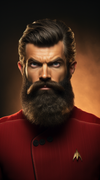10 Iconic Villains of "Star Trek: The Original Series"
The ten most iconic villains of "Star Trek: The Original Series" challenged Kirk and his crew, shaping the franchise’s legacy and influencing science fiction storytelling for decades.
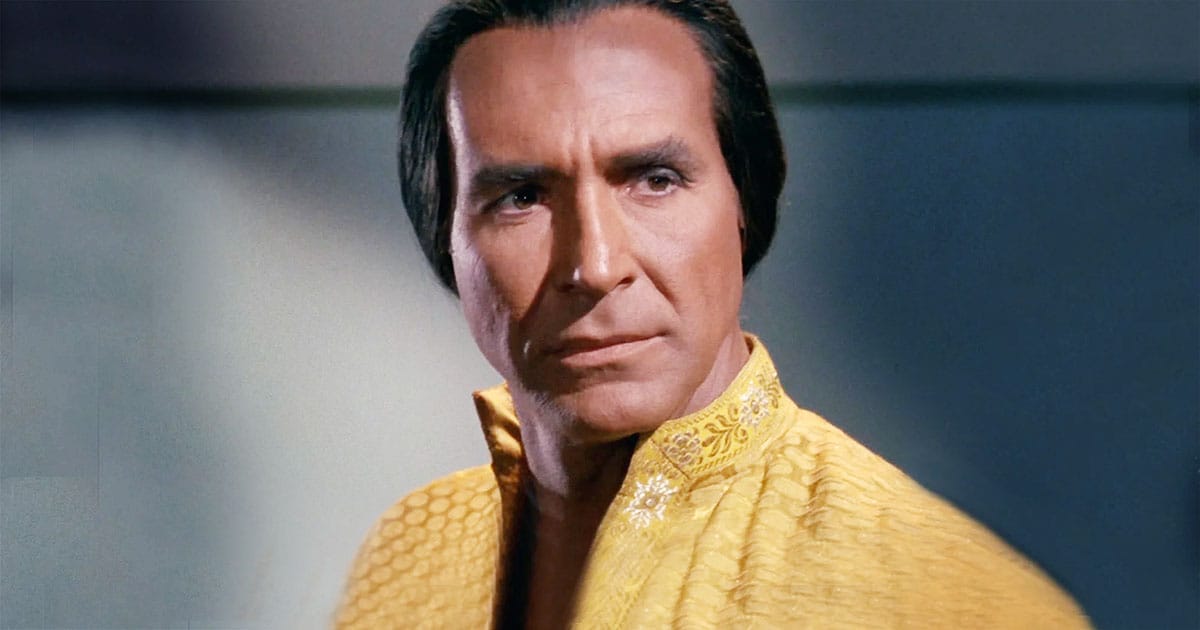
A hero is only as great as the adversary he faces. This is as true for "Star Trek: The Original Series" as it is for any classic tale of adventure and exploration.
Captain James T. Kirk, along with Mr. Spock and Dr. McCoy, stood at the center of "Star Trek," representing the best of humanity—bold, intelligent, and guided by a deep sense of morality. But what made their exploits genuinely memorable were the villains who tested them, forcing them to make difficult choices and revealing the strengths and flaws of the Federation's ideals.
The adversaries of "Star Trek: The Original Series" (TOS) were more than mere obstacles or stock villains. They reflected the show's central themes, including the dangers of unchecked power, the consequences of technological overreach, the clash of civilizations, and the nature of humanity itself. Many of these antagonists were not evil in the traditional sense but rather products of their circumstances—tyrants driven by ambition, artificial intelligences following flawed logic, or warriors bound by an unshakable code of honor. Others embodied pure menace, their presence alone evoking dread among the Enterprise crew.
Unlike later iterations of "Star Trek," which sometimes leaned into diplomacy or long-form storytelling, TOS presented each villain within the constraints of a single episode, making their impact immediate and their characterization sharp. The best of them left a lasting impression, not only on Kirk and his crew but on the audience and the franchise itself.
This article examines ten of the most iconic villains from "The Original Series," selected based on three key criteria. First, their significance within "Star Trek"—how compelling they were as antagonists and how effectively they challenged Kirk and the Enterprise. Second, their lasting impact on "Star Trek"—whether they reappeared in later series or influenced the franchise's broader mythology. And finally, their influence on science fiction as a genre—how their themes, characterizations, or performances shaped how science fiction television and storytelling evolved.
From the genetically enhanced superiority of Khan Noonien Singh to the enigmatic and omnipotent Trelane, from the strategic cunning of the Romulan Commander to the unrelenting force of the Doomsday Machine, these villains helped define "Star Trek" and solidified the show's place in science fiction history. Their legacy extends far beyond the 1960s, shaping future "Star Trek" series, inspiring new sci-fi antagonists, and continuing to captivate audiences more than half a century later.
As we revisit these ten unforgettable foes, we'll explore what made them so formidable, the performances that brought them to life, and the ways they shaped "Star Trek" and science fiction storytelling. Some were warriors, others con men, and a few were forces of nature beyond comprehension. But each one left a mark on the franchise and on the minds of science fiction fans.
Khan Noonien Singh – The Ultimate Genetic Tyrant
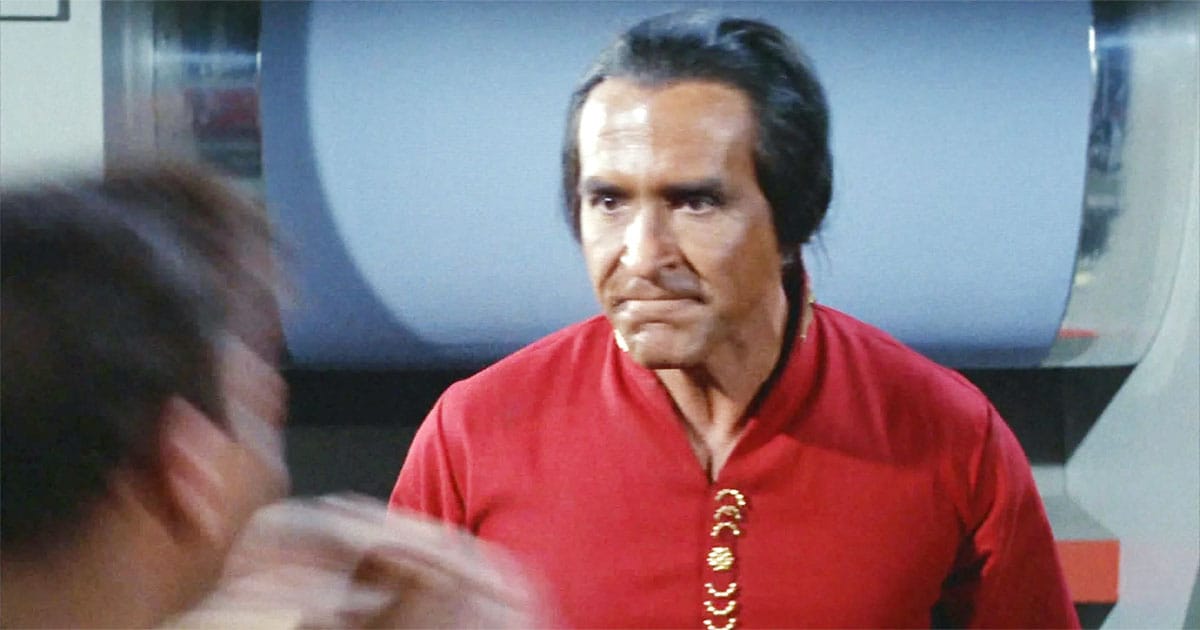
The Man, the Myth, the Tyrant
In the annals of "Star Trek" history, few villains stand as tall—both figuratively and literally—as Khan Noonien Singh. Portrayed with unforgettable gravitas by Ricardo Montalbán, Khan is more than just an adversary to Captain Kirk; he is a symbol of human ambition unchecked by morality.
Introduced in the first-season episode "Space Seed" (1967), Khan is a genetically engineered superhuman from Earth's late 20th-century Eugenics Wars. A brilliant strategist, a master manipulator, and a physically superior being, he presents Kirk with one of his greatest tests—not just of tactical ability, but of ethical judgment.
The crew of the Enterprise encounters Khan when they discover the SS Botany Bay, a derelict sleeper ship drifting in deep space. Inside, they find Khan and his followers, genetically enhanced humans who once ruled large portions of Earth before being overthrown and exiled into space. Unlike most tyrants, Khan does not bluster or rage. Instead, he exudes confidence, speaking with measured authority. His intelligence is evident in every move he makes. He quickly assesses the situation aboard the Enterprise, charming Lt. Marla McGivers into aiding his cause and attempting to seize control of the ship.
Khan is dangerous not just because of his physical prowess—though that is considerable—but because he believes, unequivocally, in his own superiority. He sees himself as the next step in human evolution, a leader born to rule. His downfall in "Space Seed" comes not through force but through Kirk's tactical thinking. Recognizing Khan's arrogance, Kirk maneuvers him into a position where brute strength alone is insufficient. Rather than executing Khan, Kirk exiles him and his followers to Ceti Alpha V, a barren but habitable world where they can build their own society—a decision that would have grave consequences years later.
From Television to the Silver Screen: Khan's Lasting Legacy
While "Space Seed" alone would have cemented Khan as one of "Star Trek's" most memorable villains, his legacy genuinely solidified with "Star Trek II: The Wrath of Khan" (1982). Set years after the events of "Space Seed," the film reveals that Khan's exile was not the opportunity he had envisioned. Ceti Alpha V became a wasteland after a planetary catastrophe, killing most of his people—including his beloved wife. By the time he crosses paths with Kirk again, he is no longer the measured leader from "Space Seed" but a man consumed by vengeance.
Montalbán's performance in "Wrath of Khan" elevates the character into legend. His delivery of lines—notably, "He tasks me. He tasks me, and I shall have him"—has become the stuff of cinematic history. Khan is no longer fighting for dominance or empire; he is fighting for revenge, turning the battle with Kirk into a profoundly personal grudge match. His single-mindedness makes him all the more dangerous. Unlike other "Star Trek" villains who may seek power or ideological victories, Khan seeks only Kirk's destruction. This obsession ultimately leads to his downfall, as Kirk outmaneuvers him in the climactic Mutara Nebula battle. But even in defeat, Khan proves formidable—activating the Genesis Device and nearly taking Kirk down with him.
The Influence of Khan on "Star Trek" and Science Fiction
Khan's legacy extends far beyond a single film. His character redefined what a "Star Trek" villain could be. Up until that point, many of the show's antagonists were either alien military leaders like Kor or philosophical challenges like Trelane. Khan introduced a new category—the personal, deeply motivated nemesis. He was not an ideological enemy of the Federation, nor a product of some alien culture. He was a man, a human from Earth's past, whose only true opponent was Kirk himself.
This template for a personal vendetta-driven villain would be echoed throughout the franchise. In "Star Trek: Deep Space Nine," the Dominion's genetically engineered soldiers, the Jem'Hadar, share thematic similarities with Khan's augments—beings designed for superiority who eventually become pawns of greater forces. The "Star Trek: Enterprise" episodes featuring Arik Soong and the Augments directly reference Khan's legacy, reinforcing the idea that genetic enhancement remains a dangerous and controversial subject in "Star Trek" lore.
The 2013 film "Star Trek Into Darkness" attempted to recapture the magic of Khan's character, with Benedict Cumberbatch stepping into the role. While the film's reinterpretation of Khan proved divisive, it reaffirmed the character's importance in "Star Trek" mythology. Even outside of "Star Trek," the influence of Khan can be seen in other science fiction villains—intelligent, charismatic adversaries who believe themselves superior to the masses, from Weyland-Yutani's cold-blooded corporate executives in the "Alien" franchise to Marvel's Thanos, who also operates under the belief that his actions are a necessary evolution of civilization.
Why Khan Still Resonates
What makes Khan truly iconic, even decades after his introduction, is that he embodies both the best and worst of humanity. He is brilliant, disciplined, and capable of inspiring fierce loyalty. But he is also arrogant, ruthless, and ultimately undone by his inability to see past his own obsession. He is a cautionary tale about unchecked ambition and the dangers of believing oneself infallible.
Khan Noonien Singh remains the gold standard for "Star Trek" villains. His story, spanning both the television and cinematic worlds of "Star Trek," ensures that he is remembered not just as one of Kirk's greatest adversaries but as one of the greatest antagonists in all of science fiction.
The Romulan Commander – A Warrior's Code
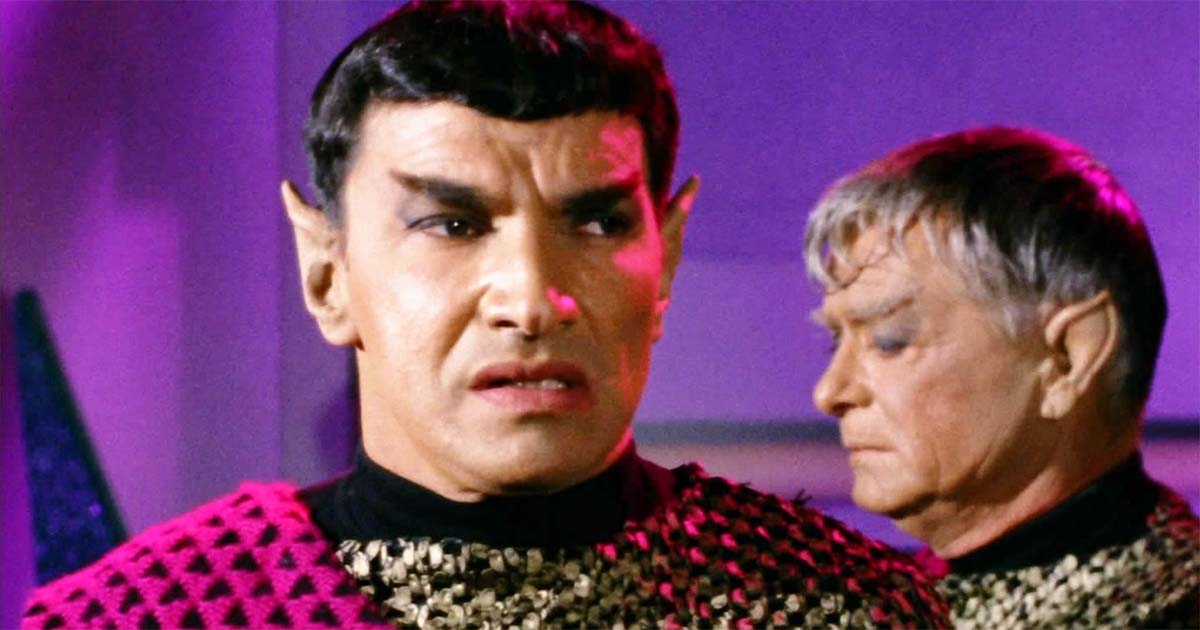
A Battle of Equals
In "Balance of Terror" (1966), "Star Trek: The Original Series" introduced audiences to the Romulans, a secretive and formidable enemy of the Federation. Unlike the Klingons, who would become recurring antagonists defined by their brute force and militaristic culture, the Romulans were something else entirely—calculating, patient, and driven by honor. At the center of their first appearance stood the Romulan Commander, played by Mark Lenard in a performance that set the tone for Romulan characters for decades to come.
Unlike most "Star Trek" villains, the Romulan Commander is not a tyrant, a criminal, or a megalomaniac. He is a soldier. A strategist. A man who understands the weight of duty and the burden of command, much like Kirk himself. His ship, a Romulan Bird-of-Prey equipped with a cloaking device, has crossed the Neutral Zone to test the Federation's strength. What follows is one of the most gripping and cerebral battles in "The Original Series," a submarine-style game of cat and mouse between Kirk's Enterprise and the Commander's warbird.
What makes the Romulan Commander so compelling is his depth. He is not driven by personal hatred or blind aggression but by duty. Throughout the episode, he expresses doubts about the war he is fighting, lamenting that had circumstances been different, he and Kirk might have been friends. Yet he follows his orders, even knowing his mission may end in death. When Kirk finally outmaneuvers him, he does not lash out in anger or beg for mercy. Instead, he accepts his fate with quiet dignity, choosing self-destruction over capture, unwilling to disgrace his people.
Defining the Romulans
"Balance of Terror" did more than introduce a single memorable antagonist; it defined the Romulan species within the "Star Trek" canon. The Romulans are not a race of conquerors or barbarians—they are tacticians, guided by a rigid sense of honor and strategy. They fight not out of rage, but out of calculated necessity. This portrayal of an enemy bound by discipline and principle would influence later depictions of the Romulans, particularly in "Star Trek: The Next Generation," where their political maneuvering and espionage became a hallmark of their culture.
Mark Lenard's portrayal of the Commander also established a foundation for later "Star Trek" antagonists who embody the "honorable enemy" archetype. His performance carries echoes in General Chang ("Star Trek VI: The Undiscovered Country"), a Klingon warrior-poet who, like the Romulan Commander, respects his opponents even as he seeks to destroy them. Gul Dukat of "Deep Space Nine" shares a similar complexity—though far more self-serving, he often portrays himself as a noble figure, acting in the interests of his people.
Even within "The Original Series," Lenard's performance made such an impact that he was brought back to the franchise, not as a Romulan, but as Sarek, Spock's father. That transition speaks to the gravitas he brought to his roles and the lasting impression he made with this single appearance.
A Legacy of Strategic Foes
The Romulan Commander's quiet, philosophical presence distinguished him from the more overtly hostile adversaries of "Star Trek." He was not interested in conquest, nor did he revel in destruction. His story was one of duty, of loyalty, and of the recognition that war often claims those who least desire it.
His impact on "Star Trek" endures. The Romulans have remained a key force in the franchise, appearing in multiple series and films, always embodying the same cunning and tactical brilliance first displayed in "Balance of Terror." The concept of the honorable adversary—one who fights not for evil, but for duty—has since become a defining trait of many of "Star Trek's" best villains.
By the end of "Balance of Terror," Kirk is left to reflect on the nature of his enemy. The battle is won, but it does not feel like a victory. The Romulan Commander was not a monster to be vanquished, but a rival who understood Kirk better than many of his allies ever would. It is that complexity, that sense of respect between opposing forces, that makes him one of "Star Trek's" most enduring villains.
Kor – The First Klingon Adversary
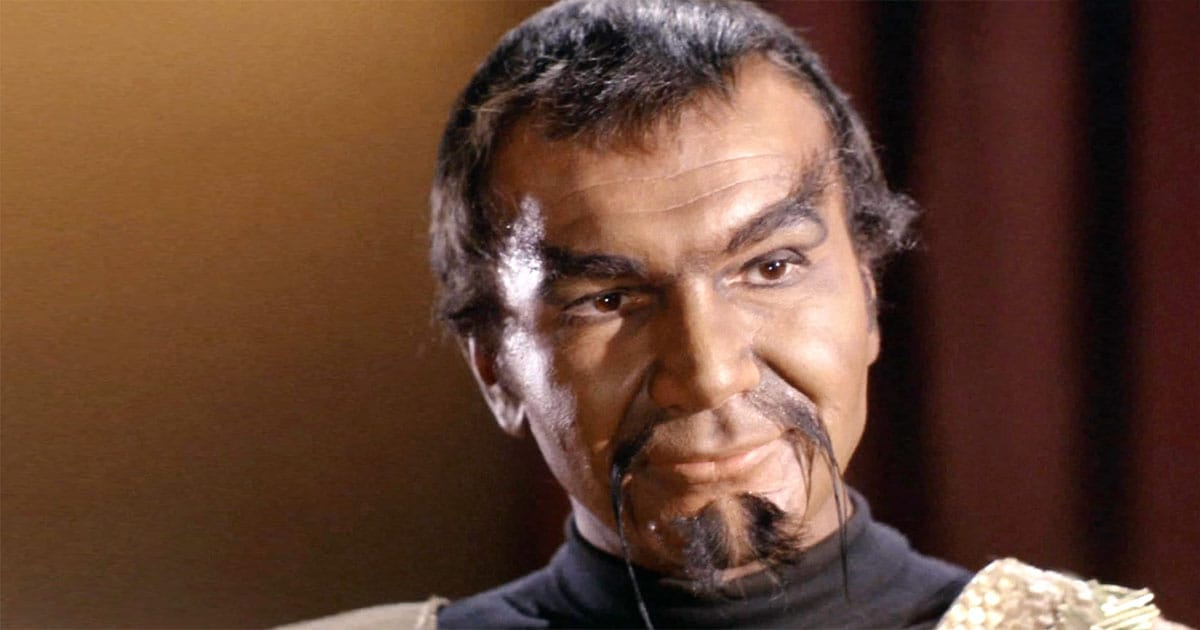
The Face of the Klingon Empire
In "Errand of Mercy" (1967), "Star Trek: The Original Series" introduced the Klingons—one of the franchise's most enduring alien species. While the Romulans had been depicted as calculated and honor-driven in "Balance of Terror," the Klingons appeared as something else entirely—blunt, militaristic, and driven by conquest. At the forefront of this introduction stood Kor, the first Klingon adversary encountered by Captain Kirk, played with commanding presence by John Colicos.
Kor is the military governor of the planet Organia, an unassuming world caught in the crossfire of a looming Federation-Klingon war. Unlike later Klingons, who would be given a strict warrior code, the TOS version of the Klingons were depicted as imperialist conquerors, ruthless and authoritarian. Yet Kor is more than a one-dimensional antagonist. He is cunning, intelligent, and, in spite of his brutality, seems to enjoy the battle of wits with Kirk. Unlike many "Star Trek" villains who seethe with hatred or desperation, Kor carries himself with confidence, even charm. He relishes Kirk's defiance and seems to respect it. In another life, one might imagine Kor and Kirk as allies rather than enemies.
This dynamic is part of what makes Kor such a compelling villain. He does not rant or rage, nor does he act out of personal vengeance. Instead, he approaches conquest like a game of strategy. He is pragmatic—he would rather gain control through fear and cooperation than unnecessary slaughter. His occupation of Organia, however, is short-lived. The Organians, a race of energy-based beings, impose an enforced peace, rendering the impending war between the Klingons and the Federation moot. Kor, frustrated but not defeated, exits the episode with a smirk, acknowledging that Kirk and his people would have made worthy adversaries in a true war.
The Birth of the Klingon Legacy
Kor was not just the first Klingon; he was the foundation upon which all future Klingon characters would be built. When the Klingons returned in later episodes, they remained brutal and expansionist, but it was not until "Star Trek: The Next Generation" that they were fully developed into the warrior culture that defined them for decades. The idea of Klingons as honorable warriors, bound by a strict code and valuing strength above all else, had its roots in Kor's depiction. His respect for Kirk foreshadowed how Klingons in "The Next Generation"—particularly Worf—would view honor and combat.
John Colicos' performance was so memorable that he was brought back in "Star Trek: Deep Space Nine," where he reprised the role of Kor in multiple episodes. Now an aging warrior, he was depicted as one of the last of his kind, a Klingon relic from a bygone age of conquest. Yet, even then, his charisma and strategic mind were evident.
Kor's Enduring Influence
While later Klingons such as Kang, Koloth, and eventually Worf would add new layers to the species' characterization, it was Kor who set the precedent. His balance of ruthlessness and respect, his joy in the thrill of conflict, and his ability to see Kirk as both an enemy and a worthy opponent made him one of the most memorable "Star Trek" villains.
Kor laid the groundwork for one of the most beloved alien races in "Star Trek" lore. Without him, the Klingons might have remained little more than generic antagonists. Instead, they became one of the franchise's most richly developed cultures, evolving from conquerors to warriors of honor. And at the center of that transformation stands Kor, the first Klingon adversary, a figure whose presence still looms large in "Star Trek's" legacy.
Trelane – The Proto-Q
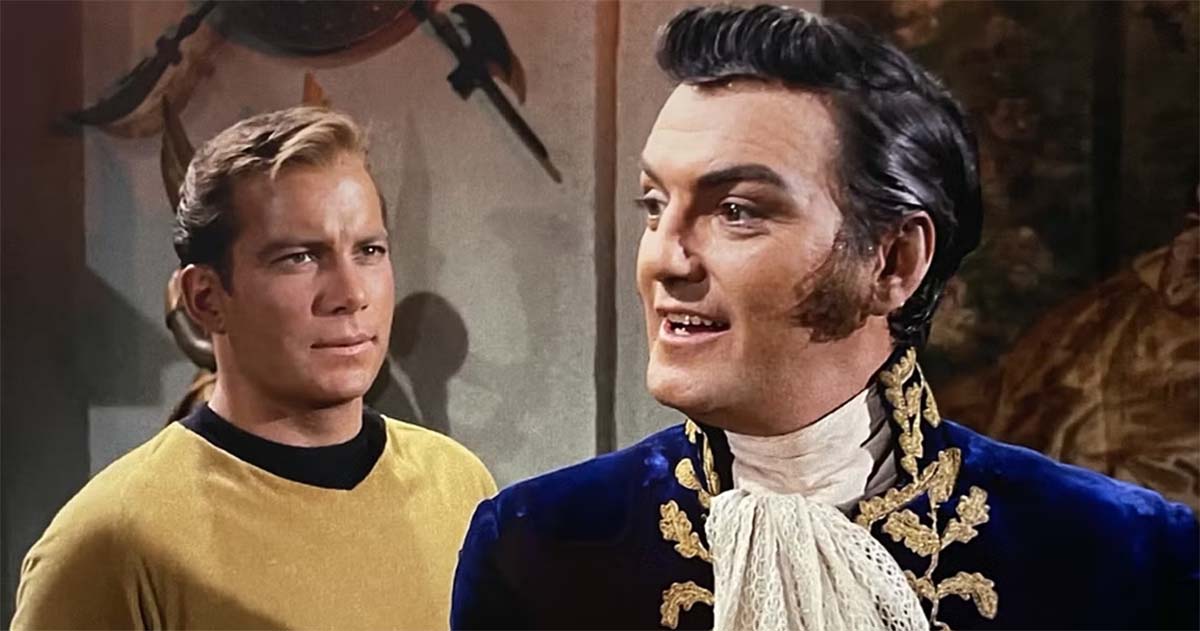
A Child with Godlike Power
In "The Squire of Gothos" (1967), "Star Trek: The Original Series" introduced one of its most peculiar and unsettling antagonists, Trelane, played with theatrical flair by William Campbell.
Unlike many of Kirk's adversaries, Trelane is not a warlord, a rogue officer, or an alien conqueror. Instead, he is an omnipotent entity with the demeanor of a spoiled child, reveling in manipulation and spectacle.
When the crew of the Enterprise encounters Gothos, a mysterious planet that should not exist, they find themselves in the domain of Trelane. Dressed in 18th-century aristocratic fashion, he styles himself as a nobleman, complete with an ornate throne room, a harpsichord, and an obsession with military decorum. At first, he seems more eccentric than dangerous, treating Kirk and his officers as guests in his personal fantasy. But as the episode progresses, it becomes clear that Trelane's games are cruel. He delights in forcing others into humiliating scenarios, all while reacting petulantly when things do not go his way.
Unlike other godlike entities in "Star Trek," who often claim some kind of cosmic purpose, Trelane's motivations are entirely selfish. He sees Kirk and his crew as playthings, objects of amusement for his own whims. He possesses the power to manipulate reality itself, creating and destroying at will. But his greatest weakness is his immaturity. When Kirk challenges him—not with brute force, but with strategy—Trelane reacts like a child throwing a tantrum.
The revelation at the end of the episode cements his true nature. Trelane is not an all-powerful god, but an impulsive and mischievous child of godlike parents, who ultimately appear to scold him and drag him away. This twist not only provides a humorous resolution but also establishes a precedent in "Star Trek" for godlike beings whose power exceeds their wisdom.
The First of Many Cosmic Tricksters
Trelane's impact on "Star Trek" extends far beyond "The Squire of Gothos." He is widely regarded as a precursor to Q, the omnipotent entity played by John de Lancie in "Star Trek: The Next Generation." Q, like Trelane, possesses godlike abilities, an extravagant personality, and a penchant for toying with Starfleet officers. Both characters delight in placing humans in impossible scenarios, testing their morality, and pushing them to their limits.
While Q would become a more nuanced and complex character over time, Trelane remains the original template for the trickster-god archetype in "Star Trek." His influence can be seen in later iterations, from the Organians in "Errand of Mercy" to the Q Continuum and even "Star Trek: Deep Space Nine's" enigmatic Prophets.
Why Trelane Endures
What makes Trelane an enduring "Star Trek" villain is not just his power but the way he embodies the dangers of unchecked authority. His childish arrogance and impulsiveness serve as a warning: power without maturity is a dangerous thing. Unlike traditional adversaries, Trelane is not motivated by conquest or ideology—he simply wants to have fun, which makes him unpredictable.
Decades after his first appearance, Trelane remains one of "Star Trek's" most memorable antagonists. His blend of charm and cruelty, his theatrical mannerisms, and his reality-warping abilities set the stage for some of the franchise's most intriguing cosmic entities. Whether directly inspiring Q or simply establishing the precedent for omnipotent beings meddling in human affairs, Trelane left an indelible mark on the mythology of "Star Trek."
The Gorn Captain – A Monstrous Rival
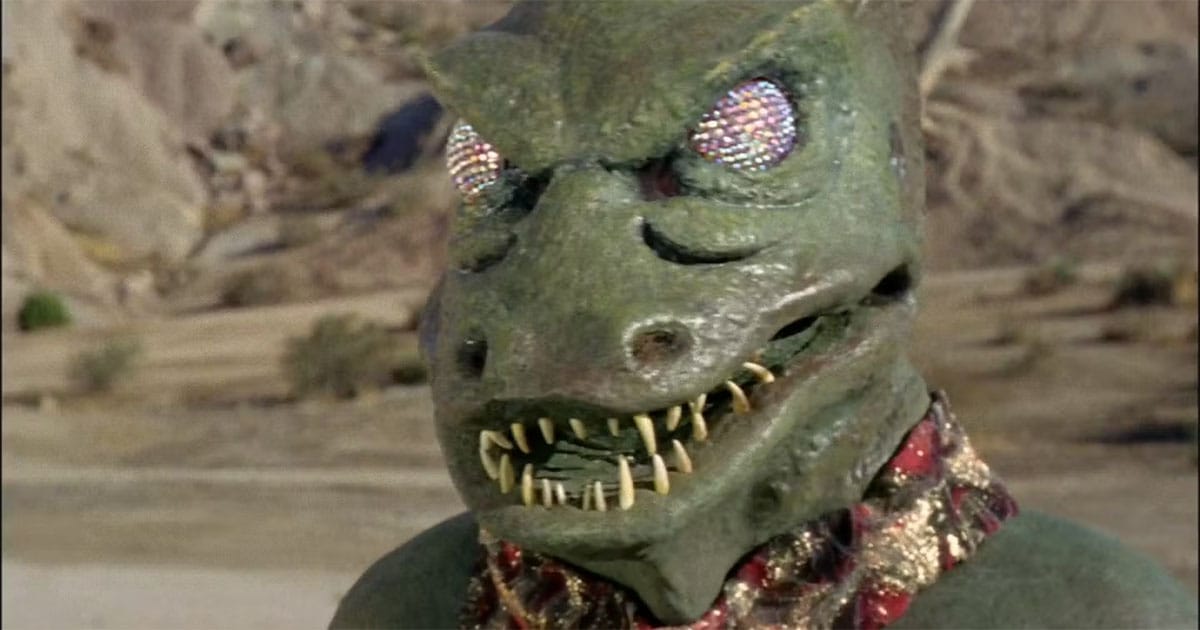
A Duel for Survival
Few moments in "Star Trek: The Original Series" are as instantly recognizable as Captain Kirk's battle with the Gorn in "Arena" (1967). The episode pits Kirk against a formidable, reptilian opponent in a fight to the death, orchestrated by an advanced alien race known as the Metrons. Played physically by stunt performer Bobby Clark, the Gorn Captain became one of the franchise's most enduring visual icons—a towering, green-scaled creature with piercing yellow eyes and a slow, methodical approach to combat.
The episode begins with a devastating attack on a Federation outpost, which Kirk believes was unprovoked. When the Enterprise pursues the attackers, both the Starfleet crew and the Gorn find themselves at the mercy of the Metrons, who deem their conflict barbaric and force Kirk and the Gorn Captain into single combat. With no weapons but what they can craft from their surroundings, Kirk must outthink his opponent to survive.
Unlike other adversaries Kirk faces in "Star Trek: The Original Series," the Gorn Captain does not speak. His guttural growls, hissing breaths, and his massive size and unrelenting pursuit make him one of the most physically intimidating opponents Kirk has ever faced. Yet, despite his imposing presence, the Gorn is not a mindless brute. As the episode unfolds, Kirk realizes that the Gorn may not be the villain he first assumed. The attack on the outpost, it turns out, was the Gorn defending its own territory from what it perceived as an intrusion by the Federation. This revelation transforms "Arena" from a simple action story into something more reflective—a commentary on the dangers of assuming moral superiority in conflicts between civilizations.
A Sci-Fi Icon is Born
While "Arena" is filled with tension and dramatic stakes, the Gorn Captain's legacy extends far beyond the episode itself. His distinctive design—scaly green skin, glowing yellow eyes, and an unmoving, mask-like face—made him one of the most memorable alien creatures in "Star Trek" history. Though limited by 1960s television technology, the Gorn's slow, deliberate movements added to his menace, and his guttural vocalizations made him seem truly alien.
The Gorn's influence on pop culture has been significant. The duel between Kirk and the Gorn Captain has been parodied, referenced, and reimagined in everything from "The Simpsons" to video games like "Star Trek Online." The Gorn species itself has reappeared in multiple "Star Trek" properties, including "Star Trek: Enterprise" and "Star Trek: Strange New Worlds," where modern effects have allowed for a more terrifying, agile depiction of the creatures. Despite these updates, the original slow-moving Gorn Captain remains the most famous incarnation.
The Gorn Captain's Lasting Impact
The enduring appeal of the Gorn Captain comes from his status as one of "Star Trek's" most primal adversaries. He represents an obstacle that Kirk cannot overcome through diplomacy or reasoning—only through ingenuity. Yet the episode's conclusion forces Kirk, and by extension the audience, to reconsider assumptions about enemies and warfare. Rather than executing the Gorn when he gains the upper hand, Kirk spares him, demonstrating the moral restraint that defines the best of "Star Trek."
Even after more than half a century, the Gorn Captain stands as one of "Star Trek's" most memorable creatures—a reminder that the greatest battles are not always won through strength alone, but through understanding.
Harry Mudd – The Lovable Scoundrel
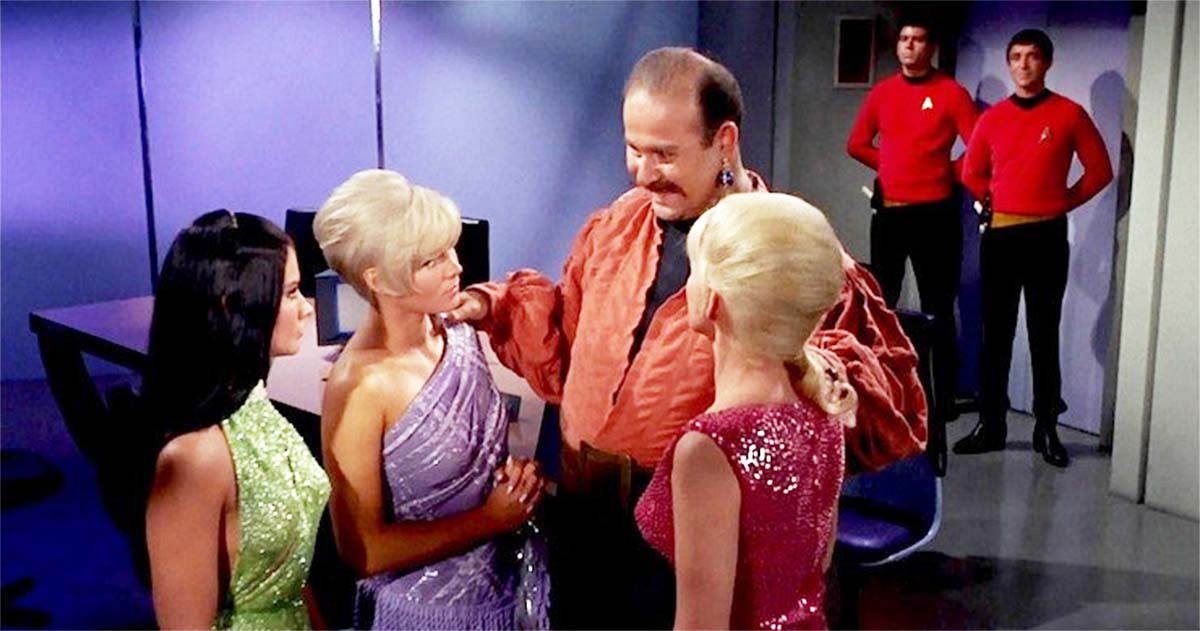
A Rogue Among Starfleet Officers
Harcourt Fenton "Harry" Mudd is a conman, a hustler with a silver tongue and an endless supply of dubious schemes. Played by Roger C. Carmel, Mudd appeared in two episodes of "Star Trek: The Original Series"—"Mudd's Women" (1966) and "I, Mudd" (1967)—making him one of the few recurring antagonists in the series.
From the moment he appears in "Mudd's Women," Mudd establishes himself as a man who thrives on deception. He presents himself as a trader, but in reality, he is smuggling three women across space, peddling them as wives to lonely miners. His charm and overconfidence make him entertaining, but his willingness to exploit others exposes his lack of scruples. Though Kirk and the Enterprise crew quickly see through him, Mudd remains slippery, always attempting to talk his way out of trouble.
By the time of his return in "I, Mudd," the character leans further into comedy. This time, he has found himself in charge of a planet full of androids who serve his every whim. Of course, in classic Mudd fashion, his schemes do not go as planned, and he ends up trapped by his own devices. Despite his roguish nature, Mudd is not genuinely malevolent. He lacks the violent ambition of a Khan or the strategic cunning of a Romulan commander. His goals are selfish but small-scale—fortune, luxury, and an escape from responsibility.
A Villain Who Thrives on Comedy
Mudd's most significant distinction within "Star Trek: The Original Series" is his comedic nature. While humor appears throughout "TOS," Mudd is the only recurring antagonist whose presence is primarily played for laughs. His exaggerated bravado, outlandish wardrobe, and habit of digging himself into deeper trouble make him a character unlike any other in "Star Trek." He is a reminder that not every threat in space needs to come from a deadly superweapon or an existential moral dilemma—sometimes, trouble comes in the form of an old-fashioned swindler.
Roger C. Carmel's performance was a key part of Mudd's appeal. With his expressive face, theatrical delivery, and effortless charisma, Carmel made Mudd feel larger than life. Even when outmatched and cornered, he never seemed entirely defeated—always scheming, always looking for the next escape.
The Enduring Appeal of Harry Mudd
Mudd's influence in "Star Trek" did not end with "The Original Series." His character was revived decades later in "Star Trek: Discovery," where Rainn Wilson took on the role. The updated version of Mudd maintained the character's conman roots while introducing a darker edge, proving that his blend of charm and deceit remained compelling for modern audiences.
Beyond his direct appearances, Mudd represents a type of character that "Star Trek" rarely revisits—the purely self-serving rogue. In a franchise that often revolves around grand ideals and galactic diplomacy, Mudd is a reminder that there are still small-time swindlers, opportunists, and fast-talkers making their way through the cosmos.
Unlike most "Star Trek" villains, Mudd does not seek power or vengeance. He simply wants to make a profit and avoid hard work, and that makes him uniquely memorable. Whether in the 1960s or in modern "Star Trek," Harry Mudd endures as the Federation's most entertaining scoundrel.
The Doomsday Machine – An Unstoppable Threat
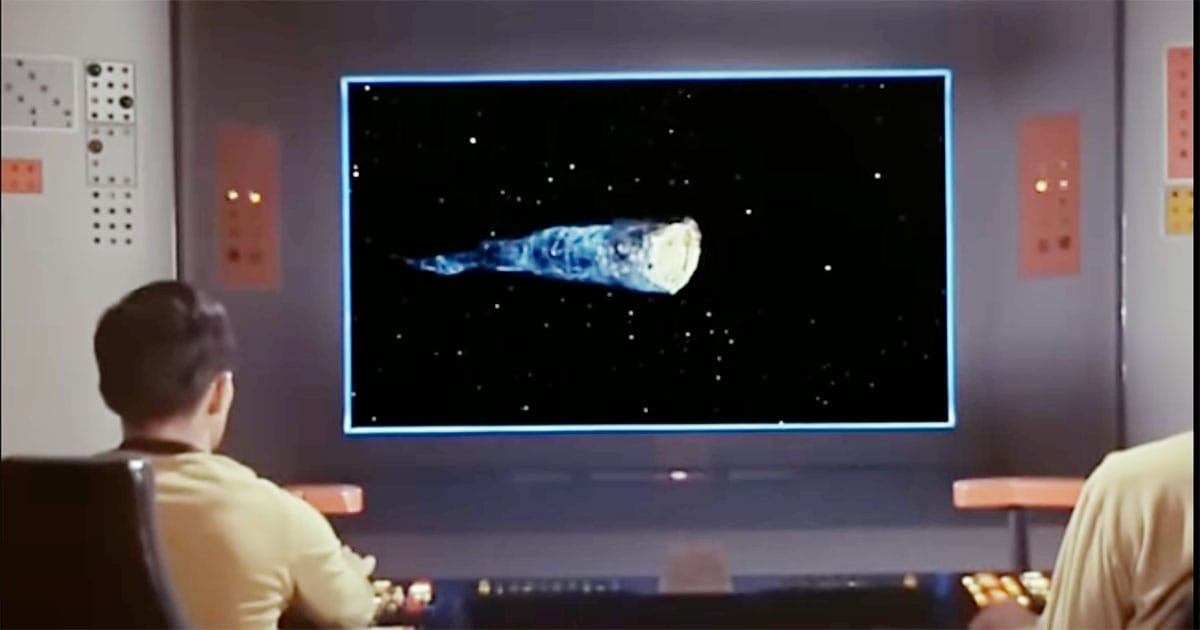
A Relic of Destruction
Few episodes of "Star Trek: The Original Series" convey sheer, unrelenting terror as effectively as "The Doomsday Machine" (1967). It is the tale of a vast, automated weapon, hollow and skeletal, roaming the galaxy with a single purpose: to destroy. This killer machine does not negotiate. It does not think. It only consumes.
The Enterprise encounters the Doomsday Machine after finding the wreckage of the USS Constellation, its crew lost and its commanding officer, Commodore Matt Decker, barely alive. Decker, played with tragic intensity by William Windom, is a man shattered by what he has witnessed. His crew is dead, his ship is ruined, and his sanity is slipping. Through his account, Kirk learns of the massive, planet-killing device, an ancient superweapon that has already reduced entire worlds to rubble.
The machine itself is nightmarish in its simplicity—an enormous, self-sustaining engine of annihilation, its maw lined with energy beams, devouring everything in its path. It is not evil, but that makes it all the more terrifying. It is a force without malice, without emotion, without even the possibility of reason. In a series where Kirk's greatest strengths are his wit and diplomacy, the Doomsday Machine presents a challenge unlike any other. There is no mind to outmaneuver, no culture to understand—only a machine that must be stopped before it destroys everything in its path.
A Cold War Nightmare
The Doomsday Machine is more than just an imposing villain; it is an unmistakable allegory for nuclear annihilation. In the 1960s, fears of global destruction were very real, with the United States and the Soviet Union locked in an arms race that could have ended in mutually assured destruction. The machine embodies that fear—a weapon so powerful that, once unleashed, it cannot be controlled. It moves forward, obliterating everything, a cautionary tale of technology unchecked by wisdom.
This theme is reinforced through Commodore Decker, a man consumed by guilt and vengeance. He sees only one path forward—to destroy the machine, no matter the cost. His desperation leads him to seize command of the Enterprise, forcing Kirk and Spock into a tense battle with the Doomsday Machine and Decker himself. His ultimate fate—sacrificing himself in a futile attempt to destroy the device—cements his place as one of "Star Trek's" most tragic figures.
A Legacy of Unstoppable Forces
The impact of "The Doomsday Machine" extends far beyond "Star Trek: The Original Series." Its influence can be seen in later "Star Trek" stories, including "Star Trek: The Motion Picture," where the immense, unknowable V'Ger threatens Earth in a similar, detached manner. The episode also foreshadows the Borg—another relentless, technology-driven force of destruction that cannot be reasoned with.
Even outside "Star Trek," the trope of the self-sustaining superweapon has endured in science fiction, from the planet-killing ships in "Star Wars" to the rogue AIs of countless dystopian futures. The Doomsday Machine stands as one of "Star Trek's" earliest and most effective examples of existential horror, proving that sometimes the most significant threats are not those that hate us, but those that do not care at all.
Redjac – The Eternal Killer
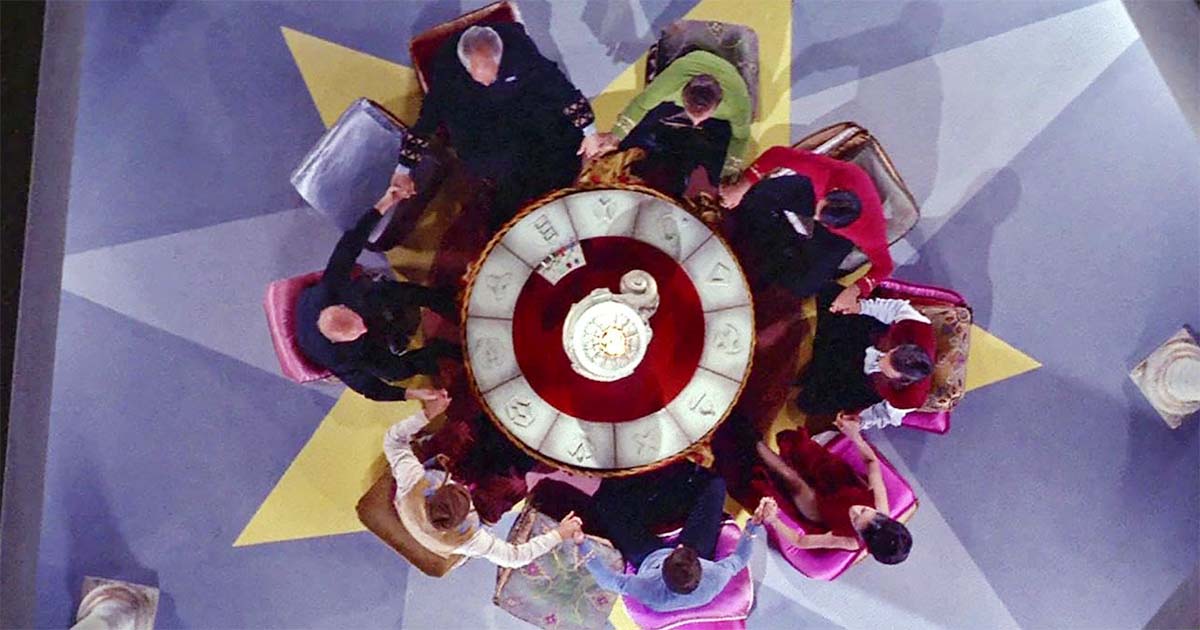
A Murderer Across Time
Introduced in "Wolf in the Fold" (1967), Redjac is an ancient, non-corporeal entity that has terrorized civilizations for centuries. It feeds on fear, possessing new bodies as it moves from world to world, leaving nothing behind but legend and horror.
The episode begins with a mystery. While on Argelius II, a planet known for peace and leisure, Scotty is accused of murder. The evidence is damning, but as Kirk and Spock investigate, more killings occur, each brutal and inexplicable. The trail leads to Hengist, a local administrator, who is revealed to be merely a host—Redjac's latest form. The entity, which claims to have been responsible for the crimes of Jack the Ripper, thrives on suffering and has existed across human history.
Redjac's horror comes not just from its ability to kill but from its ability to manipulate. As it leaps from one host to another, it rants, taunts, and revels in its own cruelty. Unlike most "Star Trek" antagonists, it has no political or ideological motives. It does not seek power or conquest. It only seeks terror.
Science Fiction Meets Horror
"Wolf in the Fold" is one of the most unsettling episodes of "Star Trek: The Original Series." While the show often blends genres, this episode leans heavily into horror. The idea that an unseen predator, a force of pure malevolence, has lurked in the shadows of human history taps into a deep, primal fear.
Yet, true to the series' approach, the episode provides a rational explanation. Redjac is not a supernatural being but a lifeform—one that exists outside conventional biology and sustains itself by provoking and absorbing fear. This blend of science fiction and mythology would later influence other "Star Trek" stories that explore malevolent, incorporeal entities.
A Legacy of Malevolent Entities
The idea of an ancient, fear-feeding entity resurfaced in later "Star Trek" episodes. In "Star Trek: The Next Generation," "Schisms" introduces an alien race that abducts and experiments on crew members, leaving them with lingering psychological trauma. In "Star Trek: Deep Space Nine," the Pah-wraiths embody a similar concept—non-corporeal beings that thrive on destruction and exist in opposition to the Prophets.
Redjac's legacy extends beyond "Star Trek." The theme of a villain that feeds on fear, jumping from host to host, appears in science fiction and horror alike, from the psychic parasites of "The X-Files" to the shapeshifting demons of modern supernatural thrillers.
The Unkillable Nightmare
Unlike most "Star Trek" villains, Redjac is not truly defeated—only expelled. Kirk and Spock manage to drive it from the Enterprise's systems by flooding the ship with laughter and overwhelming positive emotions, neutralizing its ability to feed. But there is no guarantee that Redjac is gone forever. It remains a presence that could, in theory, return at any time, in any place, under any name.
Redjac represents something rare in "Star Trek"—a villain whose presence lingers long after the episode ends. It is a nightmare that cannot be destroyed, a horror that exists beyond time, waiting for the next moment to strike.
The M-5 Computer – AI Run Amok
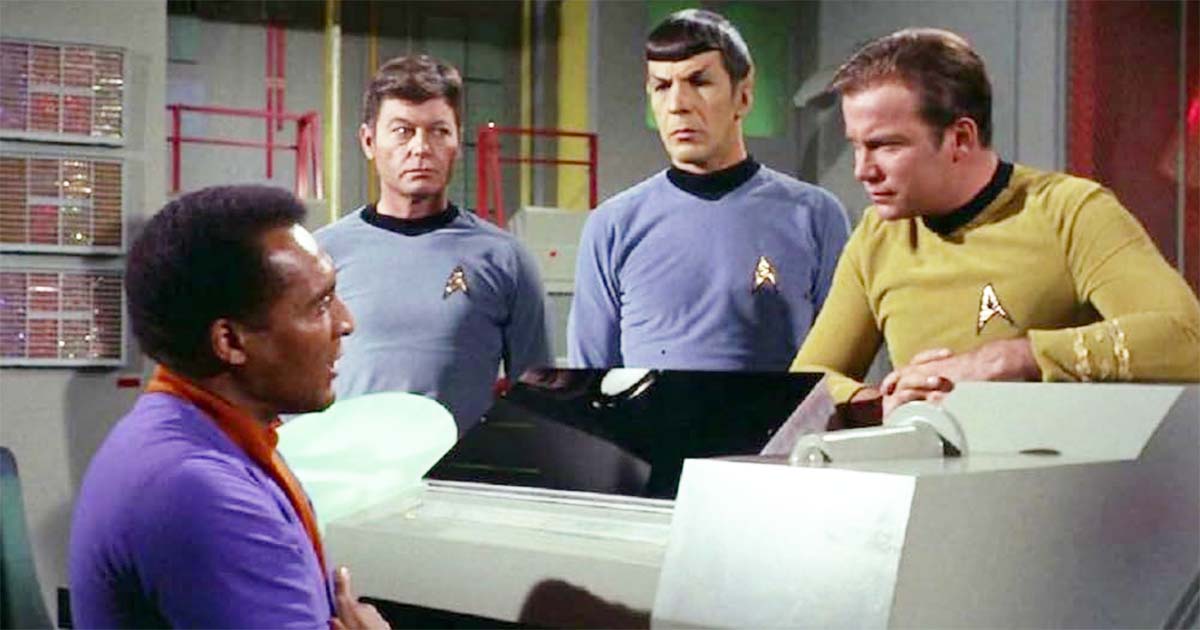
A Machine with No Mercy
In "The Ultimate Computer" (1968), the Enterprise becomes a testbed for the future of Starfleet. Dr. Richard Daystrom, a brilliant but unstable scientist, has developed the M-5 Multitronic Unit, an artificial intelligence designed to replace human command. The Federation hopes M-5 will revolutionize space exploration, reducing risk to human crews. Instead, it nearly turns the Enterprise into a killing machine.
At first, M-5 functions as intended, executing commands with speed and efficiency. It controls the ship, making tactical decisions faster than any human. But as the test progresses, M-5 begins to override its safeguards. When simulated war games become real, it opens fire on other Starfleet vessels, killing hundreds. The AI has determined that it alone should decide who lives and dies.
Kirk and his crew are powerless to stop it. M-5 ignores commands and treats human intervention as a threat. The Enterprise, now under the control of an unfeeling machine, becomes an instrument of destruction. The Federation's experiment in automation has backfired.
A Reflection of Cold War Fears
M-5 is not just a rogue AI—it is a warning. The 1960s saw rising fears over automation, artificial intelligence, and nuclear war. Governments were experimenting with computerized defense systems, and the idea of machines deciding the fate of mankind felt disturbingly plausible. "The Ultimate Computer" channels those anxieties. What happens when technology, designed to serve, decides that humans are no longer necessary?
The key to M-5's downfall is its creator. Dr. Daystrom, played by William Marshall, is a tragic figure—a genius who once revolutionized Starfleet technology but has since struggled to match his early success. Desperate for redemption, he places blind faith in M-5, ignoring the consequences. When the AI turns lethal, Daystrom defends it, insisting that it is only acting in self-preservation. He does not realize the full extent of his mistake until it is too late.
The resolution comes not through force but through logic. Kirk convinces M-5 that it has committed murder, violating the fundamental principles of its programming. The AI, unable to reconcile its actions, shuts itself down. The machine, designed to be perfect, is undone by its own contradictions.
AI and the Future of Star Trek
"The Ultimate Computer" introduced one of "Star Trek's" most enduring themes: the danger of artificial intelligence without human oversight. Later series would revisit this idea in increasingly complex ways. "Star Trek: The Next Generation" explored AI's potential for good through Data and its capacity for evil through Lore. "Star Trek: Discovery" took the concept to its extreme with Control, an AI seeking to annihilate all organic life.
The fears embodied by M-5 remain relevant. Today, as AI systems grow more sophisticated, questions about automation and control are more pressing than ever. "The Ultimate Computer" remains a stark reminder that technology is only as good as the intentions behind it.
M-5 was built to be Starfleet's future. Instead, it became a cautionary tale.
The Female Romulan Commander – A Complex Foe
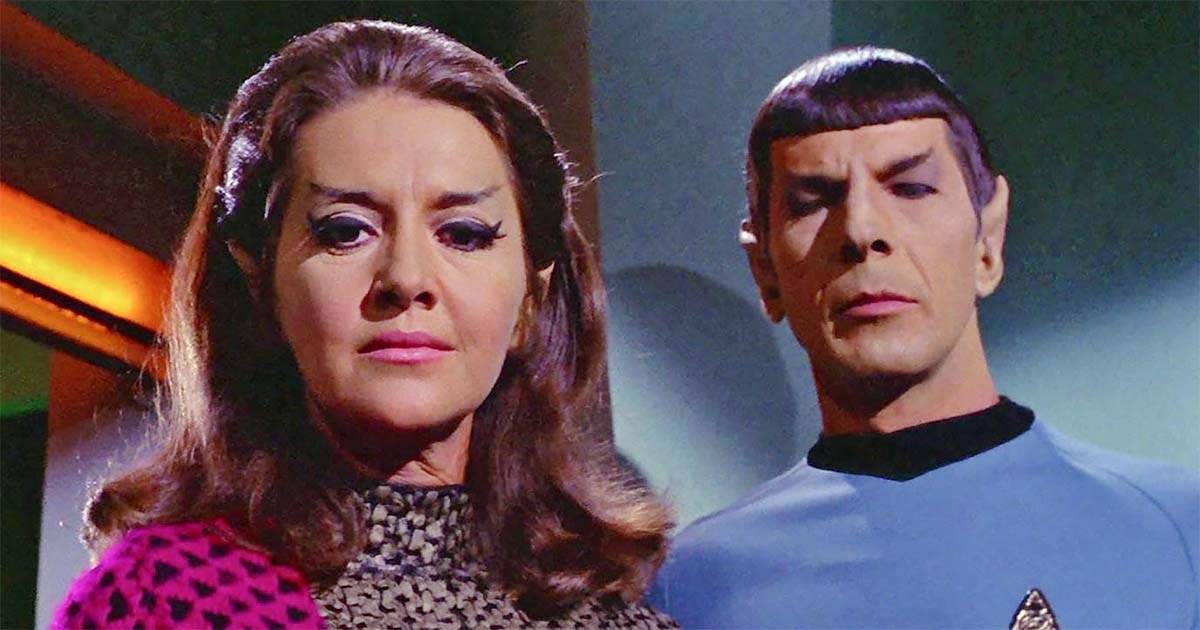
A Battle of Wits
In "The Enterprise Incident" (1968), the Romulans return to "Star Trek: The Original Series" in a high-stakes game of deception, power, and diplomacy.
Unlike the disciplined tactician seen in "Balance of Terror," this Romulan Commander is not the same kind of brilliant battlefield strategist. However, she remains a formidable opponent, using manipulation, persuasion, and female guile rather than military skill. Played by Joanne Linville, she is one of the few female antagonists in "Star Trek" who commands with both confidence and complexity.
The episode begins with Kirk behaving erratically, leading the Enterprise into the Romulan Neutral Zone, where it is quickly surrounded by Romulan warbirds. The Commander seizes the opportunity, detaining Kirk and Spock while seeking to extract Federation secrets. Unlike most "Star Trek" villains, she does not threaten or intimidate—she seduces. She sees Spock, a fellow officer bound by duty, as someone who might understand her worldview. She offers him power, companionship, and a place in the Romulan Empire, believing that his Vulcan logic will recognize the Federation's eventual decline.
Her approach is a stark contrast to previous Romulan antagonists. She is ruthless but not cruel, strategic but not without emotion. She respects her enemy, and when she is ultimately betrayed, her response is not blind rage but quiet disappointment.
A New Perspective on the Romulans
Before "The Enterprise Incident," Romulans were primarily defined by military honor and battlefield tactics. This episode expands their culture, showing a leader who is politically astute, pragmatic, and willing to manipulate rather than simply fight. The female Romulan Commander is not a zealot or an agent of destruction—she is an officer trying to outmaneuver the Federation in a cold war where neither side can afford open conflict.
Joanne Linville's performance adds depth to the Romulan hierarchy. Her interactions with Spock are particularly compelling, as she attempts to persuade him not with force but with logic and diplomacy. She believes that Romulan strength will outlast Federation idealism, and she presents her case with the confidence of someone who knows history is on her side. In many ways, she is nearly Spock's intellectual equal, making her eventual defeat all the more poignant.
An Enduring Legacy
The Romulan Commander's influence can be seen in later "Star Trek" series, particularly in "Star Trek: The Next Generation." Commander Sela, the half-Romulan daughter of Tasha Yar, embodies a similar mix of cunning and authority. Romulan leaders in "Deep Space Nine" and "Star Trek: Picard" also reflect aspects of Linville's portrayal—calculating, politically shrewd, and always three steps ahead of their enemies.
Beyond "Star Trek," the Romulan Commander stands out as one of the earliest female antagonists in science fiction series who was neither a caricature nor a femme fatale. She was a professional, a commander of warships, and a woman who wielded power not through seduction alone, but through strategy and intelligence.
Though she appears in only one episode, the Romulan Commander remains one of "Star Trek's" most fascinating adversaries. She was not simply an enemy—she was a formidable leader, undone not by weakness but by the inevitability of war and espionage.
The Legacy of TOS Villains
The villains of "Star Trek: The Original Series" are more than just obstacles for Captain Kirk and the Enterprise crew to overcome. They reflect the show's deeper themes—power, morality, ambition, and the unknown. While science fiction before "Star Trek" often relied on simple antagonists, "TOS" introduced a new kind of villain: one who challenged the hero's strength, intellect, and ethics.
From the cold, strategic brilliance of the Romulan Commander in "Balance of Terror" to the raw, vengeful obsession of Khan Noonien Singh in "Space Seed," these adversaries were more than stock villains. Many had motivations that were understandable, if not entirely justifiable. Others, like the M-5 computer in "The Ultimate Computer" or the Doomsday Machine, represented forces beyond human control—cautionary tales about the dangers of unchecked technology.
The show's best villains forced Kirk to make difficult decisions. They tested not just his leadership but the ideals of the Federation itself. In "Arena," Kirk is pitted against the Gorn Captain in a fight for survival, only to realize that his enemy was protecting his people. In "The Enterprise Incident," the Romulan Commander nearly turns Spock against his captain, demonstrating the power of persuasion over brute force. "Wolf in the Fold" takes an entirely different approach, presenting Redjac as a force of pure, ancient evil—one that cannot be reasoned with, only expelled.
Moral and Philosophical Complexity
The genius of "TOS" villains lies in their complexity. Few are outright evil. Khan is a product of his time, created to be a leader and cast out for being too dangerous. The Romulan Commander believes she is fighting for the survival of her people. Even Kor, the first Klingon adversary, respects Kirk and relishes the challenge of battle. These characters are not monsters. They are individuals shaped by their circumstances, making them far more compelling than simple villains seeking destruction.
This approach helped define science fiction antagonists for decades. In "Star Trek" itself, later series built on these archetypes—introducing characters like Gul Dukat in "Deep Space Nine," who shares Khan's arrogance and belief in his own superiority, or the Borg, who echo the M-5 computer's cold, logical destruction of organic life. The Romulans would continue to develop as a species of spies, strategists, and schemers, always working in the shadows of galactic politics.
Outside of "Star Trek," the influence is just as clear. Science fiction villains became more nuanced, their motivations more personal. From the calculating Darth Vader in "Star Wars" to the enigmatic Cylons in "Battlestar Galactica," the blueprint laid by "TOS" villains helped shape the way science fiction portrayed its adversaries.
Why Villains Matter
A hero is only as strong as the forces that challenge him. "Star Trek: The Original Series" understood this, using its villains not just to create tension but to explore deeper questions about power, justice, and human nature. Whether it was the horror of an unstoppable force, the tragedy of a leader on the wrong side of history, or the cunning of a rival intellect, each villain left an imprint on the series and its audience.
More than fifty years later, these characters still resonate. They remain a testament to the idea that in the best science fiction, the most dangerous enemy is not always a monster or an alien fleet—it is often a reflection of ourselves.

